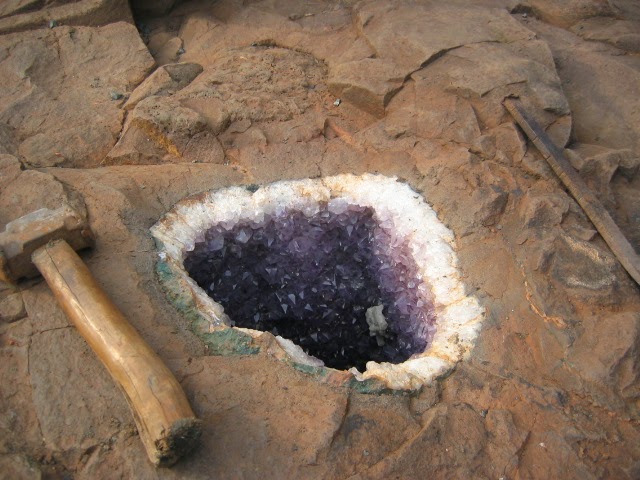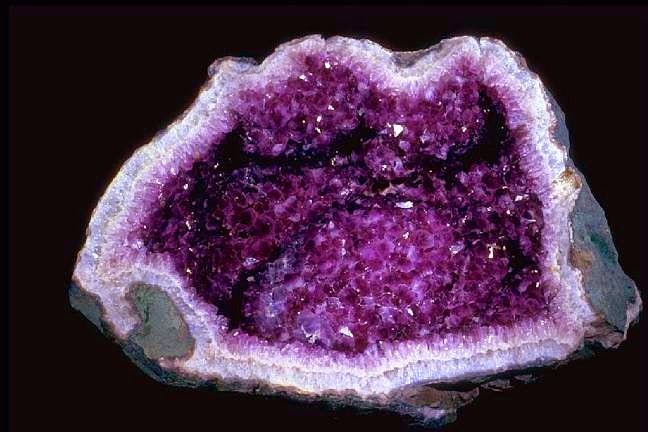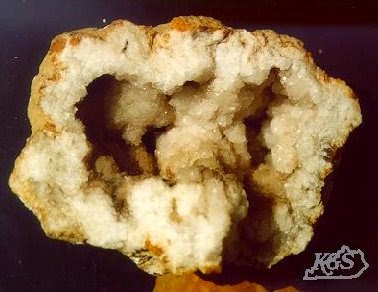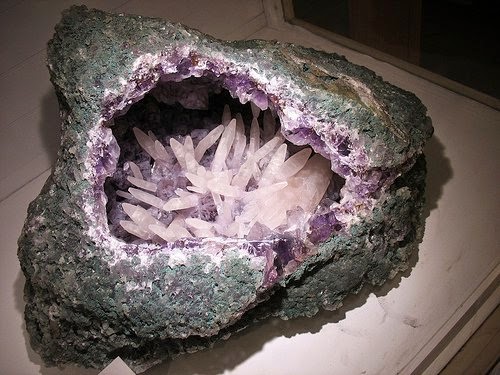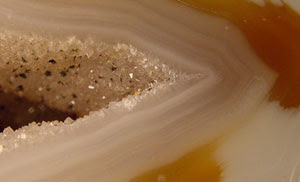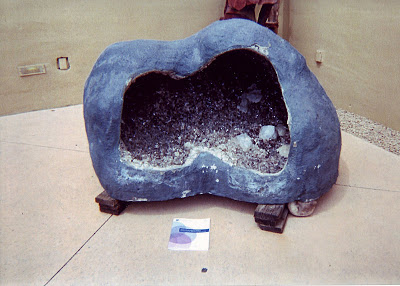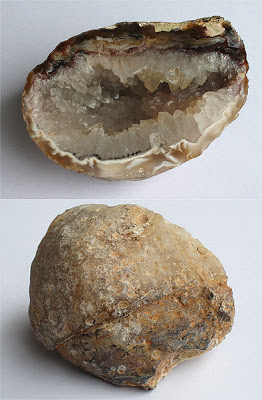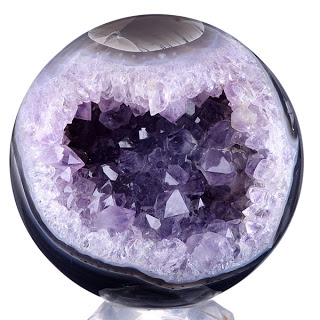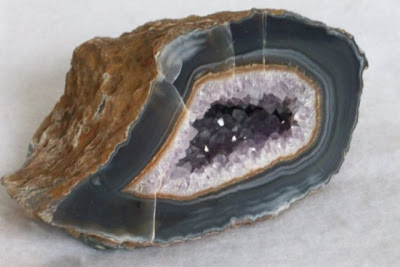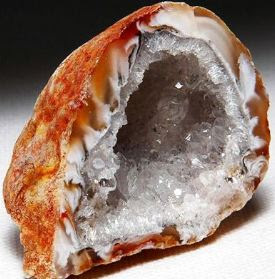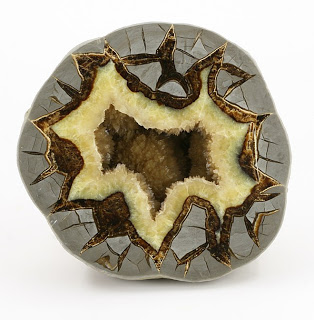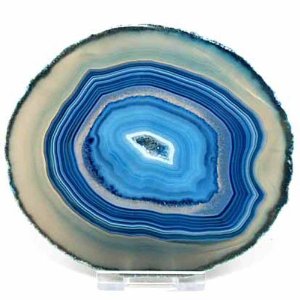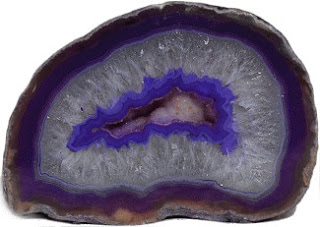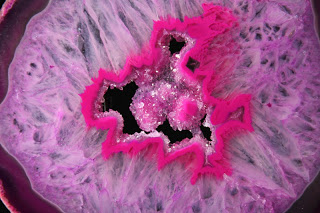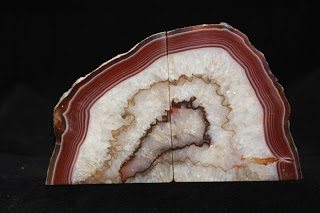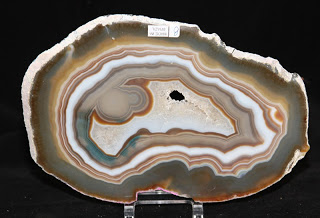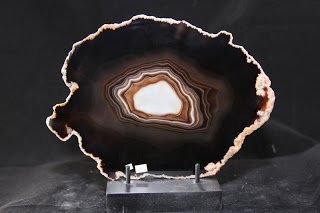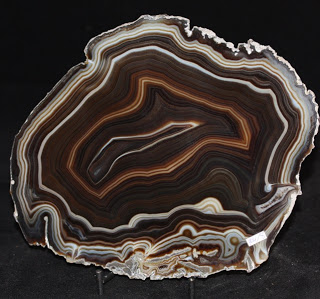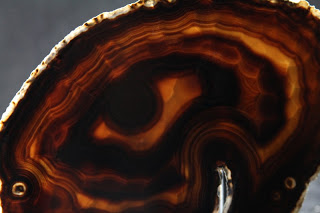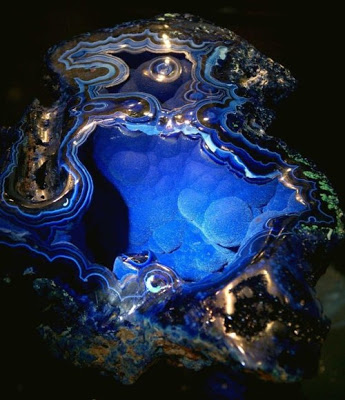
Geodes are geological secondary structures which occur in certain sedimentary and volcanic rocks. Geodes are essentially hollow, spherical to oblate masses of mineral matter that may form from either the filling of vesicles (gas bubbles) in volcanic to sub-volcanic rocks by minerals deposited from hydrothermal fluids, or by the dissolution of sedimentary nodules or concretions (that were deposited syngenetically within the rock formations they are found in) and partial filling by the same or other minerals precipitated from diagenetic or hydrothermal fluids.
Geodes differ from vugs in that the former were formed as early, rounded, structures within the surrounding rock, whereas vugs are irregular voids or cavities within a cross-cutting formation, usually a vein or breccia. Geodes also differ from “nodules” in that a nodule is a mass of mineral matter that has accreted around the nodule nucleus. Both structures had the minerals contained within, deposited from groundwater or hydrothermal processes. Geodes commonly have a chalcedony (cryptocrystalline quartz) shell lined internally by various minerals, often as crystals, particularly calcite, pyrite, kaolinite, sphalerite, millerite, barite, dolomite, limonite, smithsonite and quartz, which is by far the most common and abundant mineral found in geodes. Geodes are found mostly in basaltic lavas and limestones. The Warsaw Formation in the Keokuk region near the area where Missouri, Iowa, and Illinois join contains abundant geodes.
Formation
Geodes can form in any cavity, but the term is usually reserved for more or less rounded formations in igneous and sedimentary rocks, while the more general term “vug” is applied to cavities in fissures and veins. They can form in gas bubbles in igneous rocks, such as vesicles in basaltic lavas, or as in the American Midwest, rounded cavities in sedimentary formations. After rock around the cavity hardens, dissolved silicates and/or carbonates are deposited on the inside surface. Over time, this slow feed of mineral constituents from groundwater or hydrothermal solutions allows crystals to form inside the hollow chamber. Bedrock containing geodes eventually weathers and decomposes, leaving them present at the surface if they are composed of resistant material such as quartz.
Coloration
Most geodes contain clear quartz crystals, while others have purple amethyst crystals. Still others can have agate, chalcedony, or jasper banding or crystals such as calcite, dolomite, celestite, etc. There is no easy way of telling what the inside of a geode holds until it is cut open or broken apart. However, geodes from any one locality usually have a more restricted variety of interior mineralization.
Geodes and geode slices are sometimes dyed with artificial colors. Samples of geodes with unusual colors or highly unlikely formations have usually been synthetically altered.
Prevalence
Geodes are common in some formations in the United States (mainly in Indiana, Iowa, Missouri, Kentucky, and Utah). They also are common in Brazil, Namibia, and Mexico. A large geode was discovered in Put-in-Bay, Ohio in the early 20th century. It is known as Crystal Cave, and tours are possible during the summer. In 1967 Iowa designated the geode as the official state rock, and it has a Geode State Park.
In 2000 a team of geologists found a cave filled with giant gypsum crystals in an abandoned silver mine near Almería, Spain. The cavity, which measures 1.8 × 1.7 meters and is 8 meters in length, would be the largest geode ever found.[1] The entrance of the cave has been blocked by five tons of rocks, and is under police protection (to prevent looters from entering). According to geological models, the cave was formed during the Messinian salinity crisis 6 million years ago, when the Mediterranean sea evaporated and left thick layers of salt sediments (evaporites). The cave is currently not accessible to tourists.
The Cave of the Crystals is many meters in size, holding crystals up to 12 m in length. It may be composed of additional chambers that are obstructed by the giant crystals, so its total size is currently unknown to researchers.
Photos :
